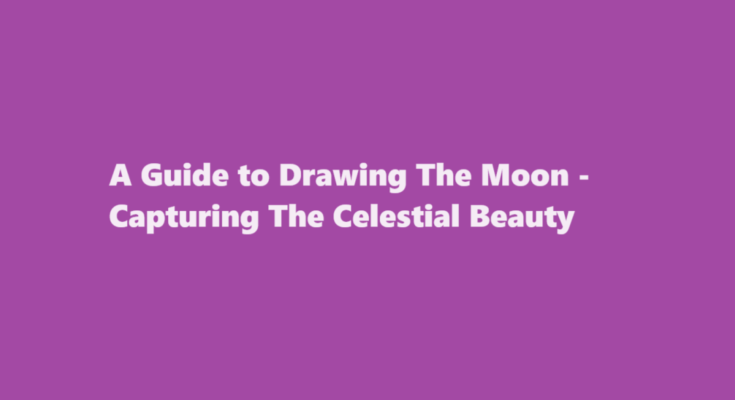The moon, Earth’s constant companion, has been a source of fascination and inspiration for artists and stargazers alike for centuries. Its luminous glow, enigmatic features, and ever-changing phases make it a compelling subject for artists seeking to capture its celestial beauty on paper or canvas. Drawing the moon can be a challenging yet rewarding endeavor, and in this article, we will explore the techniques and tips that will help you create a stunning lunar masterpiece.
Understanding the Moon’s Phases
Before you begin drawing the moon, it’s crucial to understand its phases. The moon goes through a continuous cycle of waxing and waning, and each phase presents a unique appearance. These phases range from the New Moon (when the moon is entirely in shadow) to the Full Moon (when it is fully illuminated). To accurately depict the moon, you must know which phase you intend to draw and represent it faithfully.
Essential Tools
To draw the moon effectively, you’ll need a few basic drawing tools
- Pencils Start with a soft graphite pencil (e.g., 2B or 4B) for sketching the moon’s contours and details.
- Erasers Invest in a good quality eraser, as you’ll need to correct mistakes and create highlights on the moon’s surface.
- Paper Choose a high-quality paper that can handle shading and blending without tearing or smudging.
- Blending tools Tortillons or blending stumps can help you smooth out shading and create a seamless look.
Observational Drawing
Drawing the moon often involves close observation. One of the best ways to capture its appearance accurately is to use a telescope or binoculars. These tools will help you see the moon’s craters and features more clearly. Sketching the moon while observing it through a telescope is known as “lunar sketching.” By carefully studying the moon and translating what you see onto your paper, you can create a detailed and realistic representation.
Start with a Basic Sketch
Begin your moon drawing with a basic circle to outline the moon’s shape. Be mindful of the moon’s phase and adjust the shape accordingly. For instance, during the Full Moon, the circle should be complete, while during the First or Last Quarter, it should appear as a half-moon.
Gradual Shading
The moon’s surface is filled with craters, ridges, and valleys, which create variations in shading and texture. Use your soft pencil to start shading the moon’s surface, focusing on the darker areas first. Observe the moon closely to identify the shadows and craters that stand out, and replicate them on your drawing.
Blending
After shading, use your blending tool to create a smooth transition between light and shadow. Blend the pencil marks to create a gradual change in shading, making the moon’s surface appear more realistic. Take your time with this step, as it’s essential to achieve a three-dimensional look.
Highlights
To make your moon drawing truly stand out, add highlights. Use your eraser to gently lift areas of the shading where the moon’s surface reflects the most light. The highlights should correspond to the moon’s phase, creating the illusion of craters and mountains catching the sun’s rays.
Fine Details
Next, add finer details to your moon drawing. Pay close attention to the edges of craters, the patterns of lunar maria (the dark, flat areas), and any other distinctive features. The more details you include, the more realistic your drawing will be.
Background and Environment
Consider incorporating the moon into a broader scene. Whether it’s a night sky with stars, a landscape, or a celestial event like an eclipse, the context can enhance the impact of your moon drawing. Remember to keep the moon in scale with its surroundings.
Practice and Patience
Drawing the moon, like any art form, takes practice and patience. Don’t get discouraged if your initial attempts aren’t perfect. Keep refining your technique and observing the moon regularly. Over time, you’ll improve your ability to capture its beauty on paper.
Digital Tools
If you prefer a digital approach, various software and graphic tablets allow you to create detailed lunar drawings. Programs like Adobe Photoshop or Corel Painter can help you replicate the moon’s features with precision. You can also incorporate various brushes and textures to achieve a more natural look.
Seek Inspiration
Don’t be afraid to seek inspiration from other artists and their moon-related artwork. Scour art books, online galleries, and social media platforms for moon drawings that resonate with you. Analyze their techniques and use them as a source of inspiration for your own work.
FREQUENTLY ASKED QUESTIONS
Which tool do you use to draw the moon?
A drawing compass is the best tool to use if you have one. These tools have a sharp point that you can use to rotate around to draw a perfect circle easily.
What is drawing the moon?
Drawing down the Moon (also known as drawing down the Goddess) is a central ritual in many contemporary Wiccan traditions. During the ritual, a coven’s High Priestess enters a trance and requests that the Goddess or Triple Goddess, symbolized by the Moon, enter her body and speak through her.
Conclusion
Drawing the moon is a rewarding and fulfilling artistic endeavor. By understanding the moon’s phases, using the right tools, practicing observational drawing, and focusing on shading and fine details, you can create a stunning lunar masterpiece. Remember that the key to success is patience and continuous improvement. With each drawing, you’ll come closer to capturing the celestial beauty of the moon in your own unique way. So, embrace the challenge and let your creativity shine as brightly as Earth’s loyal companion in the night sky.
Read Also : Age Requirements for Employment at Bath and Body Works



